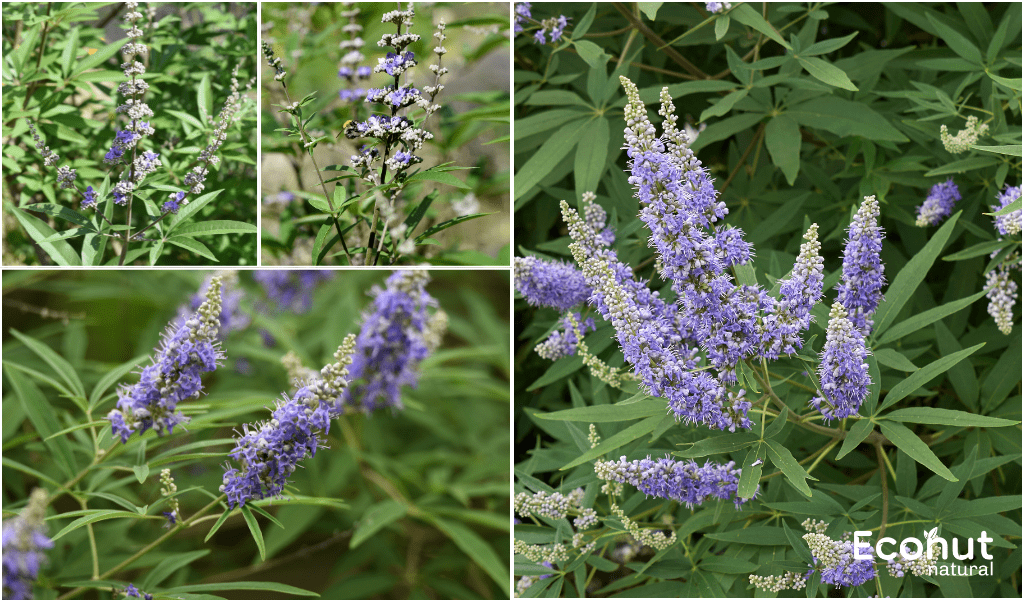Nirgundi, (Vitex negundo) is a potent ayurvedic plant with potent medicinal qualities. Among other things, it can treat anxiety, asthma, and muscle spasms.The natural habitats of niggundi are primarily found in southern Asia and Africa; it is extensively grown in the tropical climates of China, India, Indonesia, Tanzania, and Madagascar. It is a deciduous shrub that typically grows to a height of 2 to 8 meters. Its green leaves contain five leaflets, and its bark is brown.
Because niggundi is an antioxidant, it may help lower insulin levels, which may help manage diabetes. Because of its anti-inflammatory characteristics, it also aids in the management of inflammatory reactions by preventing the activation of specific mediators.
Description
Nirgundi, (Vitex negundo) contain anti-inflammatory, analgesic, antioxidant, and anti-androgenic properties. In southern China, these seeds have long been used in folk medicine to treat a variety of pain conditions, including piles, dysmenorrhea, arthralgia, stomachaches, and hernias.
Botanical Name:
Vitex negundo
Family:
Verbenaceae
Leaves:
The leaves are three to five times foliolate, with stalked leaflets that are lanceolate, acute, whole, or sporadically crenate, subglabrous above and white-tomentose below.
Flowers:
Blue, tiny flowers in peduncled cymes that produce huge, frequently compound panicles at the end of stems
Bark:
The root’s bark is yellow on the inside and green on the exterior.
Taste:
Pungent (Katu) and bitter
Parts Used:
- Leaf
- Seeds
- Root
Dosage:
- Root bark powder – 3-6- gm
- Leaf juice – 10-20 ml
- Seed powder – 3-6- gm
Chemical Constituents
Chemical constituents found in Vitex negundo Linn seeds include β-sitosterol, n-Tritriacontane, n-hentriacontanol, nhentricontane, n-pentatricontane, n-nonacosane, 3- and 4-dihydroxybenzoic acid, artemetin, 3β-acetoxyolean-12-en-27-oic acid, 5β-hydro-8,11,13-abietatrien
Medicinal Properties of Nirgundi
- Anti-asthmatic
- Anti-inflammatory
- Analgesic
- Antimicrobial
- Appetizer
- Antiandrogenic
- Discutient
- Larvicidal
- Carminative
- Emmenagogue
- Muscle relaxant
- Hepatoprotective
- Anthelmintic
- Anticatarrhal
Other Language Names of Nirgundi (Vitex negundo)
Laotian name – Khon noi
Cambodian name – Voan saich krahom
Vietnamese name – Boi hong
Kannada name – Bile-nekki
Sanskrit name – Nirgundi, Sindhuvara, Neelamanjari, Indrasurasa, Bhoothakeshi, Neelika
Hindi name – Samhalu, Saubhalu, Nirgandi
English name – Five-leaved chaste tree
Nepali name – Nirgundi
Sinhala name – Nika
Burmese name – Nat-ma-ywe
Thai name – Noi, Aenoi
Malayalam name – Indrani
Telugu name – Nallavalli, Vavilli, Tellavavilli
Tamil name: Nirkunnchi, Nallanochi
Marathi name – Nirgundi
Punjabi name – Banmairandi
Oriya name – Nigundi
Assamese name – Nilanirgundi
Filipino– Lagundi
Indonesian name – Balakulandu
Malay name – Kacang-kacangan
Bengali name – Nirgundi, Nishinda
Gujarati name – Nagod
Scientific Classification
| Kingdom | Plantae |
| Order | Lamiales |
| Family | Lamiaceae |
| Genus | Vitex |
| Species | Negundo |
Ayurvedic Properties
Hindi/Sanskrit
- Rasa – Tikta, Katu
- Guna -Laghu,Rooksha
- Virya -Ushna
- Vipaka -Katu
English
- Taste – Bitter,Pungent
- Physical Property – Light, Dry
- Potency – Hot
- Metabolic Property (After Digestion) – Pungent
Nirgundi Plant Home Remedies
- Using Nirgundi Leaf Poultice to Reduce Pain:
- Grind a small handful of Nirgundi leaves into a paste.
- Use the paste on the afflicted area, such as a sprain, muscular discomfort, or joint pain.
- For a few hours, leave it on and secure with a fresh cloth.
- The analgesic qualities of niggundi can aid in reducing inflammation and pain.
1. Nirgundi Oil:
- Infuse niggundi leaves into a carrier oil, such as coconut or sesame oil, to prepare niggundi oil.
- Use this oil topically for skin issues like acne, psoriasis, and eczema.
- Nirgundi’s antibacterial and anti-inflammatory qualities can aid in the healing of skin.
2. Nirgundi Leaf Mouthwash:
- Bring nirgundi leaves to a boil, and then allow cooling.
- Use it as a mouthwash to keep your teeth clean and fight against gum irritation and bad breath.
- The antimicrobial qualities of niggundi can help maintain a healthy and fresh tongue.
Nirgundi (Vitex negundo) Uses
Flowers:
Nirgundi flower extracts can be used to treat fever, diarrhea, and liver problems.
Roots:
The tincture and powdered root can be used to treat diarrhea. The root powder is utilized for its anthelmintic qualities. To suppress renal troubles, dissolve root extract in soft coconut water and let sit for a week.
Leaves:
Boiling niggundi leaves in water releases vapours that can be breathed.To treat headaches, three nigundi leaves can be crushed into a paste and applied to the forehead.
Seeds:
The seeds can be used to treat swellings in conjunction with vinegar or sugarcane. When combined with dry ginger and milk, powdered seeds can be used as an aphrodisiac and to treat spermatorrhea. The seeds can be ground into a paste and applied on fractures together with salt and pepper.
Fruit:
The powdered dried fruit can be eaten orally to treat indigestion, urinary tract issues, and menstruation difficulties. Mix it with warm water and toasted common salt.
Nirgundi (Vitex negundo) Benefits
Cough:
In Ayurveda, a common illness called cough is referred to as Kapha disease. The buildup and accumulation of mucus in the respiratory tract is typically the cause of coughing. Because niggundi has Ushna (hot) and Kapha balancing qualities, it assists with cough management. It eases the accumulation of mucus and prevents it from building up, which relieves coughing.
Asthma:
For patients with asthma, using nirgundi oil—a potent antihistamine—to the nose, throat, and chest reduces congestion. Comparable to sitopaladi churna, it also works well to treat bronchitis, allergies, and other respiratory conditions.
Helps with menstrual cramps:
Terpenoids, found in abundance in the fruits of Vitex negundo, are known to help women with their hormonal issues. Thus, infertility is treated and uncomfortable problems like period cramps and uterine fibroids are lessened.
Joint pain:
The alkaloid nishindine, which possesses anti-inflammatory and analgesic (pain-relieving) qualities, is abundant in niggundi root and bark preparations. When arthritis sufferers do this, their joint pain and muscle spasms decrease
Treats PMS Symptoms:
Many women experience PMS, which can cause a variety of emotional problems every month between two and fourteen days before to your period. Effectively managing the hormonal imbalance will lessen PMS symptoms. Nirgundi is a potent herbal medication that works well for treating PMS symptoms.
Liver Health:
Regulation of Liver Enzymes: It has been observed that extracts from V. negundo seeds lower serum concentrations of liver enzymes, including alanine transaminase and aspartate transaminase. This suggests a beneficial effect on liver health and function.
Diabetes Management:
Anti-Hyperglycemic Activity: Studies on animals have shown that Vitex Negundo leaf extracts contain anti-hyperglycemic properties. This study suggests that nirgundi may have a role in blood sugar management.
Relieves Anxiety:
A rich source of beneficial flavonoids and fatty acids, niggundi enhances cognitive function and memory. They also improve moods and control sleep patterns, which helps treat anxiety, sadness, and insomnia.
Averts Premature Greying Of Hair:
nirgundi has great benefits for healthy hair development. Typically, nirgundi oil extracts are combined with sesame oil and applied topically on the scalp and hair, rubbing vigorously from root to tip to enable penetration of the deeper layers. Enriched with revitalizing “Keshya” qualities that enhance hair strength and texture, nirgundi feeds the follicles that make up hair, delays the start of gray hairs, and results in a mane that is long, thick, and glossy.
Don’t miss: Sandalwood (Santalum Album): Uses, Benefits & Side Effects
Nirgundi (Vitex negundo) Side Effects
Gastrointestinal Distress:
When using Nirgundi, some people may have mild gastrointestinal discomfort, such as upset stomach or diarrhea, especially if large doses are consumed.
Hormonal Effects:
Some of the chemicals in nirgundi may have an impact on hormones. Women who suffer from endometriosis or breast cancer, or who are otherwise hormone-sensitive, should use Nirgundi with caution and under medical supervision.
Allergic Reactions:
Certain people may have allergies to niggundi or similar plants. Seek prompt medical assistance if you have symptoms such as skin rashes, irritation, swelling, or trouble breathing.
Skin Irritation:
When Nirgundi products, including pastes or poultices, are used topically, sensitive people may experience allergic responses or skin irritation.
Conclusion
nirgundi is a special and adaptable ayurvedic herb that may be used topically or internally to treat a variety of ailments, including menstrual cramps and arthritis. It enhances mental and physical health and provides benefits for holistic healing. Always seek the advice of a qualified Ayurvedic practitioner to ensure that the right dosage is being taken and to reduce the possibility of adverse effects from overuse.
FAQS
In what ways is Nirgundi used for arthritis?
To relieve arthritic pain, niggundi oil is applied gently to the afflicted joints.
Is Nirgundi suitable for usage by all users?
Yes, most people can safely use nirgundi. But it’s best to speak with a medical expert, particularly if you’re expecting, nursing, or on medication.
How can I relieve pain with nirgundi?
Nirgundi leaves can be used to generate an oil infusion, which can then be applied topically to relieve pain locally.
Can I raise nirgundi in my house?
Of course! Nirgundi grows well in home gardens. It needs frequent sunlight and soil that drains properly.
What is the purpose of Nirgundi?
Nirgundi, commonly known as the five-leaved chaste tree, is used extensively in Ayurveda, Unani, Siddha, Homeopathy, and Allopathy to treat a wide range of ailments. Many ailments, such as headaches, rheumatism, sprains, fever, coughing, urinary tract problems, boils, and sexual infections like syphilis, respond effectively to its treatment.

